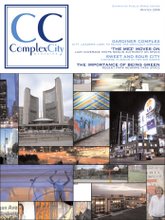The politics of postering
 BY LIZ DEWDNEY
BY LIZ DEWDNEY
Laden with 500 posters, a tub of glue and a paintbrush, Jamie Gillis rides his bike across Queen Street. Every so often he stops at a street pole, holds a poster up to it, slathers it with glue, pastes it to the pole and moves on.
Though there are people at City Hall who would like to see postering banned, Gillis says it is his right. In fact, he points out, there is a 1993 Supreme Court of Canada ruling that a complete ban on postering is an infringement on the freedom of expression, as set out in the Canadian Charter of Rights and Freedoms.
One time a bylaw enforcement officer tried to give him a ticket while he was showing a new employee the ropes, Gillis says, he informed the officer of the Supreme Court ruling.
“I told him I had every right to be doing this,” Gillis said. “In the end he walked away and I didn’t get a ticket.”
Gillis is a nine-year veteran of the billeting industry in Toronto. His company, Dr. Jamie’s Events, serves five customers at any given time. Customers such as the University of Toronto and the Rolling Stones come to him, as well as local Toronto musicians and landscapers.
Postering is part of the Toronto landscape. Lost dog owners, piano teachers and up and coming musicians all use posters to get their message out. Companies such as Dr. Jamie’s splay hundreds of posters across construction site walls, changing the white wash to a battery of colours and images. Some hail postering as free speech and free expression, while others see them as an eyesore.
A bylaw was proposed at Toronto City Hall in 2001 that would have severely restricted a posterer’s abilities. After much public debate a new version of the bylaw was introduced in 2005. This past summer a rewritten version was presented and passed.
If Coun. Rob Ford had his choice, he would never see another flyer stuck to public property again, either homemade or commercial.
“It’s destroying public property,” he said. “All posters do is pollute this beautiful city we live in.”
Ford points to posters glued over other posters as being a big problem. In some cases, he says, posters can be four or five layers thick. It also bothers him that the posters often get ripped off by passersby and thrown onto the ground, becoming litter.
Gillis admits that people, who are irresponsible in the way they display their notices, are a problem. He points to those that have placed posters on the windows of private businesses, which, he says, gets the businesses to lobby city hall for tougher regulations. Overall though, Gillis believes that postering is a necessity in Toronto.
“If you look at the small businesses or at the people who lose their cats,” he said, “for them it certainly is important to get their message out.”
Coun. Adam Giambrone believes the bylaw council put in place this summer is a viable solution, because it allows small community posters on a limited number of poles, but bans blanket and corporation postering.
“We’ve all seen examples of postering gone awry,” he said. “But it’s just not practical to ban all forms of postering.”
Ford admits a total ban would be difficult to enforce. He says names are often not included on posters, making it difficult to hand out fines. But he believes that through public education programs and enforcement officers the city could be free of posters once and for all.
“If we start making exceptions for some,” he said, “then where does it end?





No comments:
Post a Comment